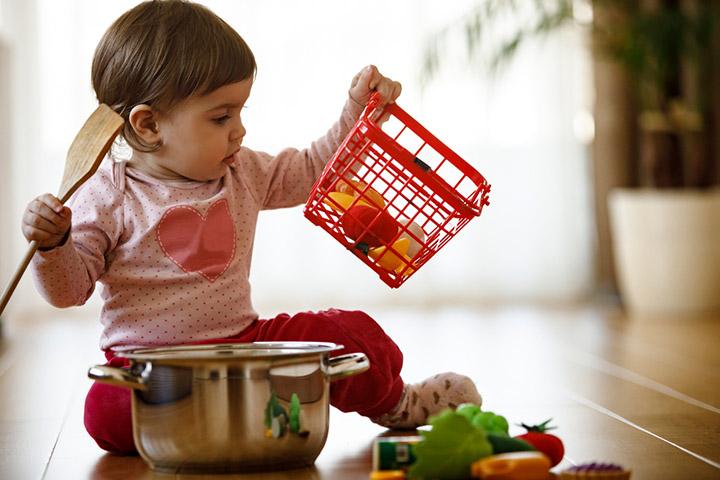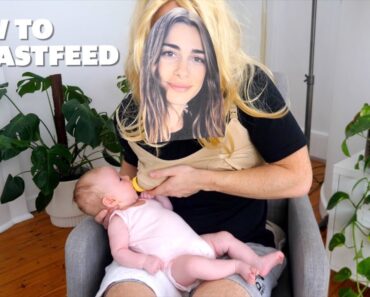Planning activities for your one-year-old can be fun and exciting, provided you understand their developmental milestones. At one year of age, babies become increasingly mobile and interactive. In addition to getting into a sitting position independently, most of them can stand and walk with support. Also, they can hold small objects, such as a crayon, between their thumb and forefingers (pincer grasp) and imitate scribbling (1) (2).
These developments indicate that your baby can go beyond rattles and squeaky ducks. So, indulge in various age-appropriate activities with your one-year-old to keep them engaged, active, and happily playful. Also, these activities can support their further growth and development.
This post shares various fun and learning activities that you and your one-year-old can enjoy together.
Fun And Engaging Activities For One-Year-Olds
Here are some activities that allow you to spend quality time with your toddler while supporting their active growth and development.
Sensory activities
1. Explore sensory basket
One-year-olds are inquisitive, and they satiate their curiosity with active exploration of the things using their hands and mouth. You can give your toddler a plastic basket filled with baby-friendly toys of different shapes, textures, and colors. Sit with them and motivate them to explore the basket. As they pick the toys, interact with them and guide them to see, touch, and feel the toys.
2. Finger painting
Finger painting is a creative activity that lets babies see and touch different colors. For that, spread an old newspaper or white paper on the floor or a high chair and give some non-toxic, washable finger paints to your one-year-old. Let them dip their fingers in the colors and paint as they like. You can make the activity interactive by talking to your toddler about different colors and drawing random shapes with them. The activity can get messy, but don’t let that stop you from spending some quality time with your little one.
3. Crawl and walk feel
For this activity, you would need a feet-and-feel mat. A feet-and-feel mat is made with fabrics of varying colors and textures, such as fake grass, sponge, and velvet. When a baby/toddler crawls or walks on a feet-and-feel mat, they see different colors and feel textures. This tactile sensation and visual perception help them learn their surroundings better. So, crawl, stand, touch, walk on these sensory mats with your one-year-old and have fun.
4. Write on crumbs
Most babies enjoy touching, feeling, and throwing small beads and pebbles. It’s a type of self-play with which babies engage with the environment around them and learn cause and effect. So, give your toddler a plastic container or plate filled with colored rice cereal or crumbled crackers and trace shapes or random figures on the crumbs. Then, motivate them to do the same and see how playful your one-year-old gets.
5. Spaghetti hide and seek
Peek-a-boo is a classic game that refines a baby’s object permanence understanding. One of its entertaining modifications is spaghetti hide and seek. For this activity, place a few small toys under colorful spaghetti and give the spaghetti bowl to your one-year-old. Let them dive their hands and fingers into the bowl and enjoy playing with spaghetti. Finding toys hidden beneath the spaghetti is an added element of excitement that will spark joy.
6. Pick and drop
Place a few bowls filled with colored rice, animal-shaped cereal, and green peasin front of your toddler. Now, pick some colored rice from the bowl and drop it into a plate. Do the same with cereal, peas, and other items. While you do this, talk to your one-year-old and encourage them to follow you. In no time, you will find your zealous toddler imitating you. Indulging in a pick-and-drop activity will also hone your tiny tot’s motor skills.
7. Puppet play
Buy sock, rod, glove, and finger puppets and play with your one-year-old. This classic toddler activity keeps your one-year-old busy while you narrate a story using puppets. What’s fun is that you can DIY these puppets at home using old household items, such as a cardboard box, old socks, wool, and leftover embellishments. Just let your creativity flow and make unique puppets for your toddler that you both can cherish even after they grow up.
Gross motor activities
8. Baby obstacle course
Put some soft pillows and cushions on the floor to make a baby ramp. Now, let your toddler crawl or walk over them to move from one side of the ramp to another. Performing this simple activity will refine your toddler’s gross motor skills. Besides, it will make them a sense of independence in motion that they will thoroughly enjoy. Keep altering the complexity of the activity as your baby masters crawling and walking.
9. Dance on song or rhyme
Dancing is a great gross motor activity that can fine-tune your baby’s balance and coordination skills. So, clear the floor and play some music with a fast tempo. Alternatively, you can sing some rhymes, such as an itsy bitsy spider, wheels on the bus, or five little monkeys, to encourage your toddler to dance. Also, if possible, place a big mirror in the room so that the baby could watch themselves while dancing. Finally, use some dancing props, such as ribbon wands and fans, to make dancing amusing for your 12-month-old.
10. Cardboard tunnel
Use some old cardboards and make a crawl-through tunnel using them. Hang some sensory toys inside the tunnel or leave them on the floor. Now, keep your baby at the entrance of the tunnel and encourage them to go inside. You can play some music to make the activity more cheerful. This activity hone’s your toddler’s gross motor and exploration skills.
11. Cleaning up the room
Scatter different toys around the baby’s room. Then, ask your toddler to pick up the toys and put them in the toy bin or basket. Doing so will refine the toddler’s gross motor skills and develop a sense of responsibility in them from a tender age. You can make this activity a daily chore by encouraging your toddler to pick up their toys after playing.
12. Fetch the ball
Teaching children to listen and follow instructions from a young age is a valuable parenting practice. You can do this with your one-year-old by giving them instruction during different activities. One such activity is fetching the ball. For this activity, take your toddler to a park or your home’s backyard. Now, throw the ball up to a short distance and ask your toddler to fetch it. When your toddler crawls and walks with support to get the ball, it will polish their cognitive and gross motor skills.
13. Pushing toys
A pushing toy is the most basic yet effective way to refine a baby’s gross motor skills. Not only will it help your toddler practice standing, but it will also help them take steps and move around. You can check several different pushing toys, such as a cart or car, in the market or make one at home using cardboard, wooden sticks, and old tins. Make sure the toy is sturdy enough to bear your toddler’s weight.
14. Puzzle-solving
Puzzles seem to be something that grown-up children love. But you can involve your one-year-old in age-appropriate puzzles for enhanced motor skills and logical reasoning. At this age, solving the puzzle is more about using hands and forefingers to pick puzzle pieces and fit them as directed. So, sit with your young toddler and do some puzzle-solving together. While working the pieces in the jig-saw, keep talking to your toddler and teach them about different colors, objects, animals that the puzzle contains.
15. Busy board
A busy board is a classic DIY activity where you can stitch or paste different sized zips, buttons, buckles, and other items on a cardboard or wooden board. Now Sit with your toddler and show them how to unzip, unbutton, and unbuckle. Once they learn that, teach them zipping, buttoning, and buckling. Involving a young toddler in such exploratory activities helps improve their motor skills, enhance agility, and tune eye-hand coordination. Just remember, start this activity with big-sized zips, buckles, and buttons and then gradually reduce their size.
16. Pull the toys
This exciting and fun activity can polish your one-year-old’s motor skills. All you need is to spread cardboard on the floor and spread toys on it for the activity. Then, tape these toys using adhesive tape, and the activity is ready. Now, place your toddler on the floor near the cardboard. Sit alongside them and show them different ways, such as pulling, to remove the toys from the board.
Fine motor activities
17. Sponge squeeze
Soak some colorful sponge in a water bucket or container. Place this bucket or container on the floor and make your toddler pick and squeeze the sponge. This simple yet playful activity will keep your baby engaged and refine their eye-hand coordination and fine motor skills. Play along with your one-year-old as most toddlers during this activity splash water, which raises the risk of slipping or tripping.
18. Piggybank
The pincer grasp is an essential milestone in fine motor development. So, teach your child to utilize their pincer grasp to do simple things, such as holding coins and dropping them in a piggy bank. You can give small and big-sized coins to your one-year-old and demonstrate how to pick and drop the coin. While the toddler is practicing their new-learned skill, stay vigilant that they don’t put the coins in their mouth as they are a potential choking hazard.
19. Stacking blocks
Stacking blocks is an engaging activity that requires a toddler to pick the blocks, hold them, and stack them one over another, fine-tuning their motor and cognitive skills. Give differently shaped, colored, and textured stacking blocks to your one-year-old and build towers or random structures with them. Open-ended, foam, or plastic blocks are safe to use over wooden blocks as most toddlers tend to throw objects while playing.
20. Pin and pull the clothespins
Clothespins are a common household item that you can utilize to make an engaging and joyful activity for your one-year-old. For the activity, you need different color clothespins and some cardboard cylinders with threads passing through their centers. Now, sit with your toddler and show them how to pin the clothespin to the thread and pull the cylinder. Do this a couple of times to help your toddler mimic you.
21. Threading the pasta
Babies as young as six months old can practice threading and beading under parental guidance and supervision. So, give some colorful uncooked pasta to your one-year-old and ask them to thread it to wooden sticks. You can stand the wooden sticks on homemade playdough or a thermocol box. This super simple activity can keep your toddler entertained while honing their fine motor and cognitive skills.
22. Decorating edible playdough
Decorating an item is a creatively engaging activity suitable for children across ages. Let your one-year-old’s imagination and creativity flow while they decorate different things, such as Christmas trees, Easter eggs, and cupcakes made with homemade edible playdough. Give them easy-to-pick colorful items such as beads, pompoms, and shiny sequins for decoration.
23. Scribbling with crayons
Scribbling is a common activity that babies can begin from 12 months of age. Holding a crayon and then scribbling it on paper requires both fine and gross motor skills. Additionally, it lets your toddler be imaginative, which is vital for their cognitive development. So, don’t hesitate to give your one-year-old some big crayons and a white sheet to scribble on. Be their play companion and scribble with them. Make the activity interactive by telling them about different colors.
24. Sticking board
Sticking an item on a surface can sharpen your toddler’s eye-hand coordination, motor, and cognitive skills. You can make a DIY sticking board using old cardboard, Velcro, watercolors/paints, and embellishments. To make a Velcro board, make a flat cardboard table and paste Velcro strips on it. Then, using the leftover cardboard, make different shapes or items, such as a flower, triangle, and leaf.
After that, cut these shapes and color/paint them. Finally, adorn these shapes/items with embellishments and put them in a box or container. Sit with your toddler and show them how to pick the cardboard cutouts and stick them on the Velcro board. Soon, they will mimic you and will master the art of sticking.
25. Cotton tip painting
Cotton tip painting is a step ahead of finger painting. Like scribbling with crayons, you can help your one-year-old paint using cotton tips. For this activity, all you need is some non-toxic colors or paints, a few cotton buds or Q-tips, and a white sheet or chart paper. Now, sit with your toddler and show them how they should dip a cotton bud tip into the paint, and then use it to paint on the white sheet. At first, a lot of color spilling will happen, but all that is a part of fun learning.
Educational activities
26. Count finger and toes
For a one-year-old, identifying numbers before learning to count is necessary. So, spend some time with your toddler daily and count fingers and toes with them. For this, just touch one finger or toe at a time and say the number aloud. Your toddler may not be able to say numbers yet, but they can begin recognizing their names.
27. Shape sorting
Shape/color sorting is a fun-filled educational activity that can teach toddlers about different shapes and colors. You can buy an age-appropriate shape/color sorter from the market or make one at home. Sit with your toddler and show them how to sort blocks based on colors and shapes. Talk to them about the process to make the activity interactive. Regular indulgence in shape sorting activities can enhance a toddler’s observation and memory skills.
28. Naming familiar objects
Most 12-month-olds can recognize, identify, and name a few everyday objects/things (3). So, expose your toddler to different things daily and help them remember and recognize them. This activity looks ordinary, but it’s crucial to hone their cognitive skills. Besides, interacting with surroundings is essential for toddlers to attain a sense of confidence.
29. My first sounds
At one year of age, babies are becoming increasingly aware of their surroundings. So, it’s the right time to teach them about different birds, animals, and objects that make sounds. Doing so not only familiarizes them with different sounds but also teaches them the concept of individuality. You can make a customized sounds book or buy one. Most sound books have questions, like “I hear someone say meow..meow.., who’s it?” or “There it shouts bow..bow.., name who’s it?”
30. Bathing bath toys
Most babies like playing with different bath toys, such as ducks and frogs. But what about cleaning those toys? Of course, you may be cleaning them regularly, but how about involving your one-year-old? Well, the idea might seem challenging at first, but it’s great fun for toddlers. So, the next time you put your toddler’s favorite bath toys for washing, call your toddler for help. Let them soap the toys and rub them clean. Doing so can teach your young child about the importance of cleanliness and hygiene of the self and surroundings.
31. Cereal alphabets
Spread a large chart paper on the floor. Then, make letters on the chart paper, such as A, B, C, and D, using baby cereal. Next, ask your toddler to pick one cereal from the letter “A” and pronounce the letter. For instance, when your toddler picks a cereal or a couple of them from the letter “A,” say aloud “A,” and ask your toddler to repeat after you. In the same way, teach your little toddler numbers and shapes.
Social activities
32. Pass the ball
Pass the ball is a classic activity to strengthen a baby/toddler’s large muscles. But did you know that the same activity can teach them self-regulation and patience? Well, when your toddler throws a ball at you, and you throw it back to them, it teaches them to act in cooperation. Also, when they wait for their turn to throw the ball, it teaches them self-regulation.
33. Stroll in a kid’s park
Social interaction is best learned when practiced. Take your one-year-old to a children’s park and introduce them to children of different ages. Let them play with other children and see how they enjoy interacting with them. You can also take your child to a shopping mall, community program, or beach to give ample social exposure. Teach them how to talk and greet to learn interacting with others in the right manner. Remember, toddlers and young children mimic their elders. So, interact with people around you appropriately.
34. Phone a friend
Toddler phones with cute stickers and attractive tunes are a great tool to teach your toddler social skills. You can make a toddler phone at home using an old cardboard box. All you need to do is cut the box into a phone shape, paste white paper on it, and mark numbers to make a dial pad. Now, pretend to dial a number and talk. It will motivate your toddler to mimic you when you pass the phone to them.
35. Labeling the emotions
Most babies express their emotions by 12 months of age. But, they don’t know which emotions are associated with what feeling. Here labeling the emotions activity can help. For that, read a storybook with pictures to your toddler. While reading, show the toddler different faces with emotions in the book and explain what feelings are associated with those emotions.
For instance, if the story has a picture of a happy baby, show the picture to your one-year-old and tell them that the baby in the picture is smiling or laughing because he is “happy.” In the same way, show different emotions, such as anger, sadness, joy, and fear to your toddler, to help them know about feelings.
36. Ready to help
12-month-olds don’t yet know what “help” means, but you can teach them about helping by involving them in household chores. Of course, babies at this age can’t run around and help you, but they can undoubtedly point or pick an object when you ask about it. Therefore, use this skill of theirs to teach them the concept of help or assistance. For that, just ask your toddler about familiar objects like “Where’s mama’s cup,” “where’s daddy’s bottle,” or “can anyone pass me the carrot.” Now, ask your partner or caregiver to help the toddler point or pick that item and then pass it to you.
37. Pretend play
Toddlers mimic their elders. It is why several one-year-olds begin to pretend play. You can turn your toddler’s pretend play game into a learning experience. For instance, you can tell your toddler that their favorite toy, such as a bunny, is a baby, and you both need to feed, bathe, and put the baby to sleep so that they grow and stay healthy.
Likewise, you can get a baby doctor’s kit and ask your one-year-old to treat the baby so that it may get better. Indulging in such imaginative games is good to boost your baby’s creativity and hone their logical reasoning skills. It also teaches them several practical life lessons, such as showing empathy and being kind.
Outdoor activities
38. Gardening
Gardening is a skillful activity that one-year-olds will not understand, but they will certainly enjoy doing it. While you tend your plants in the backyard, take your toddler along and talk them through the process. You will notice that they will try to mimic you when you sow seed or cut a leaf. So, utilize this opportunity to acquaint your baby with nature, give them small tools,such as a plastic watering can, and help water the plants. Keep pointed objects, such as a grafting knife and shovel away, for the toddler’s safety.
39. Exercising
Exercising is healthy for you and your toddler. However, a one-year-old can’t do body maneuvers as you could do to exercise. Yet, they can join you in exercising to enjoy watching and imitating you. Take your toddler along with you to a park where you both can practice some yoga poses together. This activity is guaranteed fun when your baby is kept under the supervision of a caregiver while you exercise. Other than exercise, you and your toddler can crawl on the grass together, which your toddler will enjoy.
40. Make a sandcastle
Making a sand house on the beach is what people across ages like to do. You can introduce your 12-month-old to this fun activity by taking them to a beach. If you don’t have a beach nearby, buy a sandcastle kit and practice sandcastle making in your backyard. Pour the sand in a big bucket or tub, and let your toddler jump in to have creative fun. Then, join along with your toddler to spend some quality time together.
41. Bubble making
Running behind bubbles is a playful activity that toddlers love. Buy a bubble-making kit with bubble wands of varying sizes. Then, take your one-year-old to a garden or park with open spaces where your toddler could crawl and walk with support. Next, make bubbles using the bubble-making kit and set your toddler free to chase them.
42. Nature walking
Nature walking is a relaxing activity that even a one-year-old can do. Put your toddler into a stroller and take them out for a nature walk early morning or in the evening around sunset. While walking, talk to your one-year-old and show them the birds, trees, and butterflies to expose them to various elements of the surroundings.
Alternatively, you can put your toddler on the grass and let them experience nature by touching the grass and flowers around. Doing so not only exposes a toddler to nature’s beauty, but it’s a great way to enhance their vocabulary while having some fun time outdoors.
43. Baby ball pool
Most toddlers enjoy throwing objects, such as a ball, to practice their dexterity and eye-hand coordination. You can bring an inflatable ball pool and place it in your backyard. Fill the pool up with balls of varying sizes and colors and let your toddler free in the ball pool to enjoy. Join your one-year-old in this simple yet fun activity and spend some quality time together. You can add some water to your pool to add more fun to the activity.
Your baby turning one is a special milestone. Since they are growing fast and achieving new skills, it’s good to expose them to several age-appropriate activities supporting their growth and development. You can start with activities that are simple and gradually build their difficulty level to challenge your toddler. When your one-year-old is doing activities, ensure you also take part in the activity so that you both spend some quality time together.


































